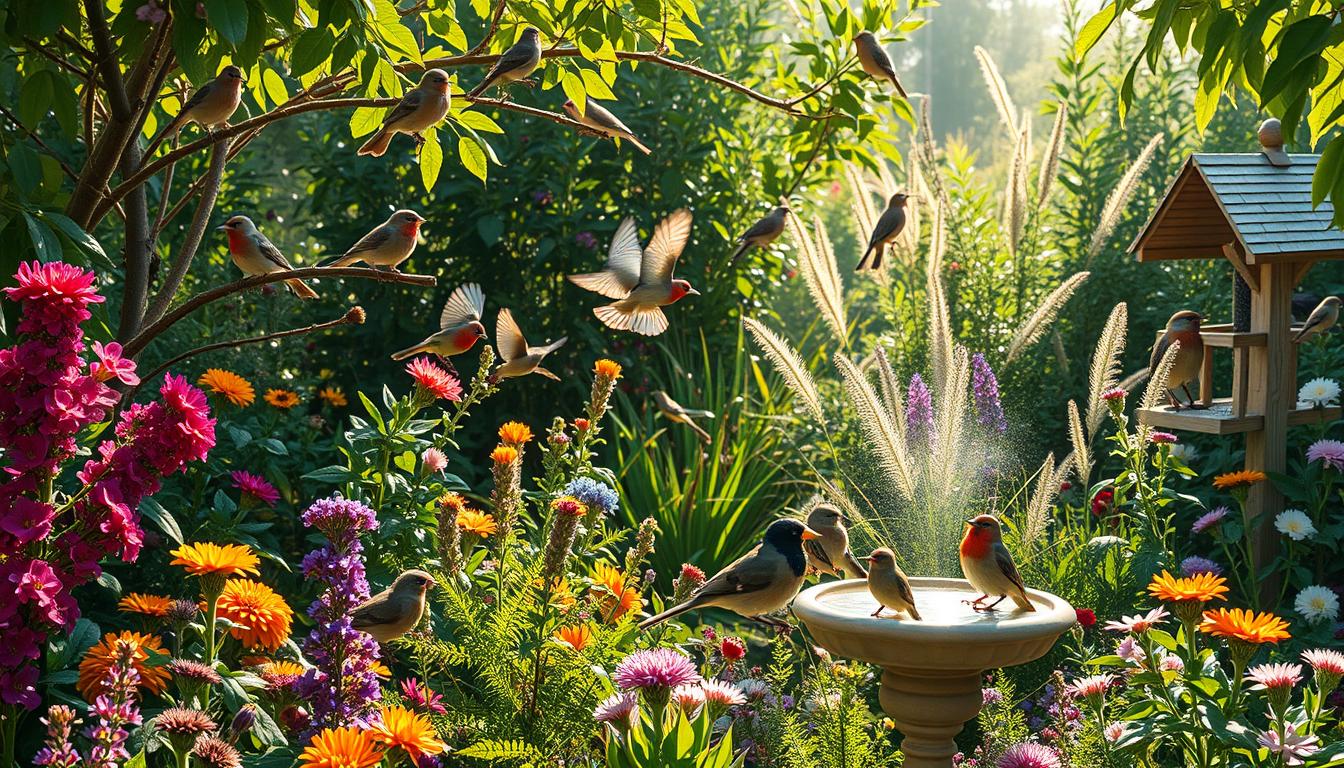I’m excited to share my guide on how to build a bird-friendly garden. Creating a space that welcomes our feathered friends is rewarding. It’s not just about beauty; it’s about supporting local wildlife and connecting with nature.
In this guide, I’ll walk you through the steps of bird-friendly landscaping. We’ll cover everything from understanding what birds need to choosing the right plants. By the end, you’ll have the know-how to transform your yard into a vibrant bird sanctuary.
Ready to start your journey in creating a haven for birds? Let’s dive in and explore how to make your garden a hotspot for our winged visitors!
Understanding the Needs of Garden Birds
Creating a backyard bird habitat is all about meeting the basic needs of our feathered friends. Attracting birds to my garden is more than just putting out a feeder. Let’s explore the key elements that make a garden irresistible to birds.
Food Sources
Birds need a variety of foods to thrive. I make sure to offer different types of seeds, fruits, and insects in my backyard bird habitat. Here’s a quick guide to what some common birds prefer:
| Bird Species | Preferred Food |
|---|---|
| Cardinals | Sunflower seeds, safflower seeds |
| Finches | Nyjer seeds, thistle |
| Woodpeckers | Suet, peanuts |
| Robins | Mealworms, berries |
Water Requirements
Water is crucial for attracting birds. I’ve installed a birdbath in my garden, providing a spot for drinking and bathing. Keeping the water clean and fresh is essential. During winter, I use a heated birdbath to ensure a constant water source.
Shelter and Nesting
Birds need safe places to rest and raise their young. I’ve incorporated dense shrubs, trees, and birdhouses in my garden design. Different bird species prefer various nesting spots, so I provide a mix of options. This approach has really boosted the bird activity in my backyard!
Choosing the Right Plants
Choosing the right plants is crucial for a bird-friendly garden. Native plants are the best for attracting birds. Let’s look at the different types that can make your garden a bird paradise.
Native Flora Benefits
Native plants are great for birds. They offer food and nesting materials. Plus, they fight off pests and diseases without harmful chemicals.
Flowering Plants for Pollinators
Flowers make your garden beautiful and attract insects. These insects are a favorite snack for birds. A mix of nectar-rich flowers keeps the garden lively all year.
Fruit and Seed-Bearing Options
Birds need fruits and seeds for food. I plant berry, nut, and seed-producing plants. This keeps birds coming back to my garden all year.
| Plant Type | Examples | Bird Species Attracted |
|---|---|---|
| Native Shrubs | Elderberry, Serviceberry | Robins, Waxwings |
| Flowering Plants | Coneflower, Sunflower | Goldfinches, Hummingbirds |
| Seed-Bearing Plants | Black-Eyed Susan, Asters | Chickadees, Finches |
By using native plants, flowers, and fruit-bearing plants, I’ve made my garden a bird haven. Mixing these types supports many bird species all year.
Creating a Birdbath
Adding a birdbath to my garden is a great way to attract birds. Bird baths offer a water source and add charm. Let’s explore how to set up the perfect birdbath.
Ideal Location and Design
Think like a bird when picking a spot for your birdbath. I place mine near shrubs or trees for a quick escape. The design is key too. I like shallow basins with gentle sides for birds of all sizes.
Maintenance Tips
Keeping your birdbath clean is key. I change the water every few days and scrub it weekly to stop algae. A small brush helps remove debris. Birds, like us, prefer clean water.
Seasonal Considerations
In winter, I use a birdbath heater to avoid freezing. In summer, I add a dripper to keep water moving. This attracts more birds and fights mosquitoes. Adapting to seasons makes my birdbath a year-round haven.
Creating a birdbath is more than just providing water. It’s about offering shelter and enhancing your garden. With these tips, you’ll have a lively birdbath that brings joy to you and your bird friends.
Designing Spaces for Birds
Creating a backyard bird habitat is more than just planting trees and setting up feeders. Thoughtful design is crucial to attract many bird species. Let’s look at how to design spaces that meet different bird needs.
Open Areas vs. Dense Cover
In my garden, I mix open spaces with dense vegetation. Open areas are great for ground-feeding birds like robins and sparrows. They need space to search for insects.
Dense cover, on the other hand, is essential for bird shelter. Thick bushes and shrubs protect birds from predators and harsh weather.
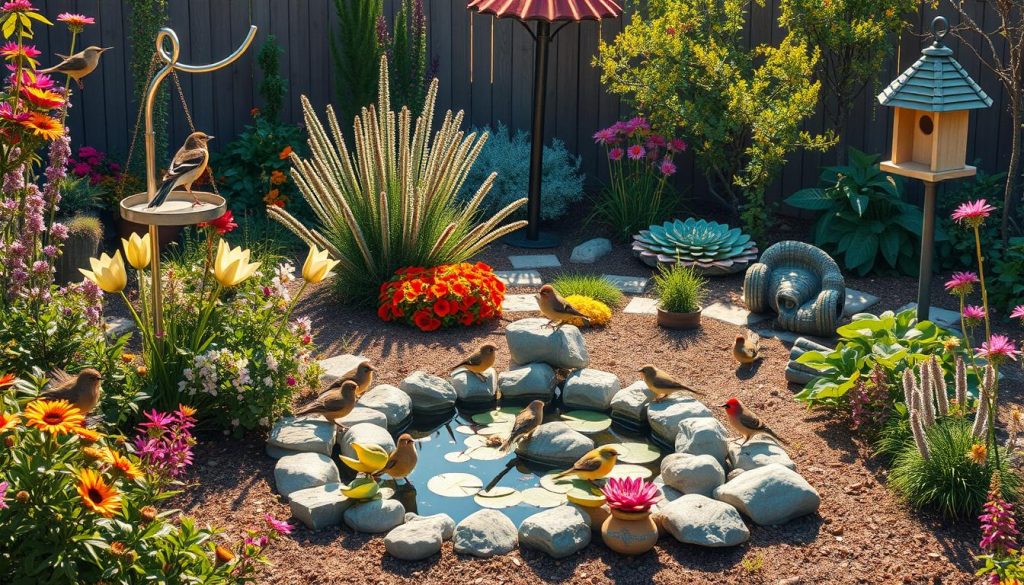
Perches and Resting Spots
Birds need places to perch and rest in your garden. I’ve added natural and artificial perches. Here’s what works well:
| Perch Type | Benefits | Best Locations |
|---|---|---|
| Dead branches | Natural look, various thicknesses | Near feeders, scattered in trees |
| Birdhouses | Nesting spots, winter shelter | 5-10 feet high, away from feeders |
| Roosting pockets | Cozy shelter, especially in winter | In sheltered areas, near dense foliage |
By adding these elements, I’ve made a diverse bird habitat. Providing shelter for birds is as important as food and water. With a mix of open areas, dense cover, and varied perches, your garden will become a bird paradise.
Implementing a Feeder Station
Setting up a feeder station can make your garden a lively spot for birds. Let’s look at how to do it right.
Types of Feeders
There are many bird feeders, each good for different birds. I mix them to attract a variety. Platform feeders are best for big birds, while tube feeders are for the small ones. Suet feeders are a favorite among woodpeckers and nuthatches.
Best Seeds for Common Birds
Choosing the right seeds is crucial for attracting birds. Black oil sunflower seeds are a favorite among many. Nyjer seeds attract finches, and safflower seeds are loved by cardinals. Here’s a quick guide:
| Seed Type | Birds Attracted |
|---|---|
| Black Oil Sunflower | Chickadees, Titmice, Nuthatches |
| Nyjer | Goldfinches, Siskins |
| Safflower | Cardinals, Grosbeaks |
| Cracked Corn | Doves, Sparrows, Jays |
Feeder Placement
Where you put your feeders is important. I’ve found success near trees or shrubs for a quick escape. Keep them about 10 feet from these natural covers. This setup attracts birds to my garden while keeping them safe.
Incorporating Native Trees and Shrubs
Using native plants for birds is crucial for a bird-friendly garden. Native trees and shrubs are essential for attracting birds.
Benefits of Trees for Birds
Trees are vital in my bird-friendly garden. They offer high perches for songbirds and protective cover for nesting. Since I planted native species, I’ve seen more birds visiting.
Oak trees, for example, support over 500 caterpillar species. These caterpillars are a key food source for many birds.
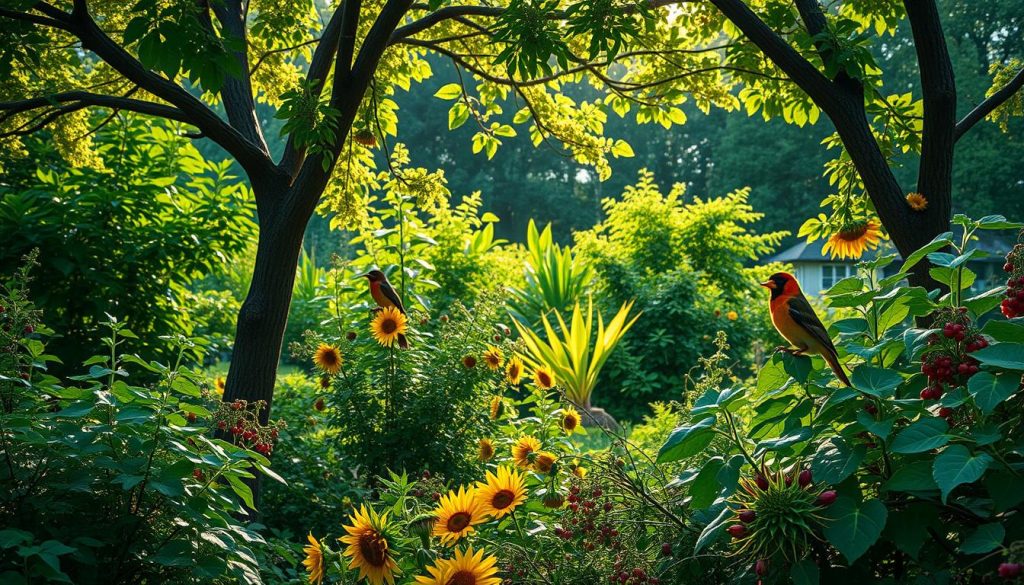
Top Shrubs for Bird Attraction
Shrubs are key in bird-friendly landscaping. They provide food, shelter, and nesting sites. I’ve had great success with berry-producing shrubs like elderberry and serviceberry.
These plants are not only beautiful but also offer a feast for birds throughout different seasons.
| Native Shrub | Bird Species Attracted | Benefits |
|---|---|---|
| Elderberry | Robins, Bluebirds, Catbirds | Berries, Nesting |
| Serviceberry | Cedar Waxwings, Grosbeaks | Fruit, Insects |
| Dogwood | Cardinals, Thrushes | Berries, Cover |
By incorporating these native plants for birds, I’ve created a diverse habitat. My garden is now a bustling hub of avian activity. Thoughtful bird-friendly landscaping can make a real difference.
Avoiding Pesticides in the Garden
Creating a bird-friendly garden means saying no to harmful chemicals. Pesticides can harm birds and other wildlife. Let’s look at safer ways to keep our feathered friends safe and healthy.
Natural Pest Control Methods
I’ve found natural pest control works well in my garden. Companion planting is a great method. I plant marigolds near veggies to keep pests away.
Another trick is to attract beneficial insects like ladybugs and praying mantises. They eat harmful bugs and keep the ecosystem balanced.
Keeping Chemical Use Minimal
Sometimes, natural methods aren’t enough. When I need to use chemicals, I do so sparingly and carefully. I choose organic, biodegradable options when I can.
I apply them early in the morning or late in the evening when birds are less active. It’s important to read labels and follow instructions to protect our bird habitats.
By using eco-friendly practices, I’ve seen more bird activity in my garden. It’s rewarding to know my efforts are making a difference. A healthy garden ecosystem benefits birds, wildlife, and plants alike!
Providing Nesting Materials
I love helping birds build their homes in my garden. By offering nesting materials, I create a welcoming environment for feathered friends. This not only supports bird populations but also brings the joy of watching families grow right in my backyard.
Safe Options for Nest Buildup
When providing nesting materials, safety is key. I stick to natural fibers that won’t harm birds or their chicks. Here’s a list of safe options I use:
- Grass clippings (untreated)
- Small twigs and pine needles
- Moss and lichen
- Pet fur (clean and free of treatments)
- Plant fluff (from cattails or milkweed)
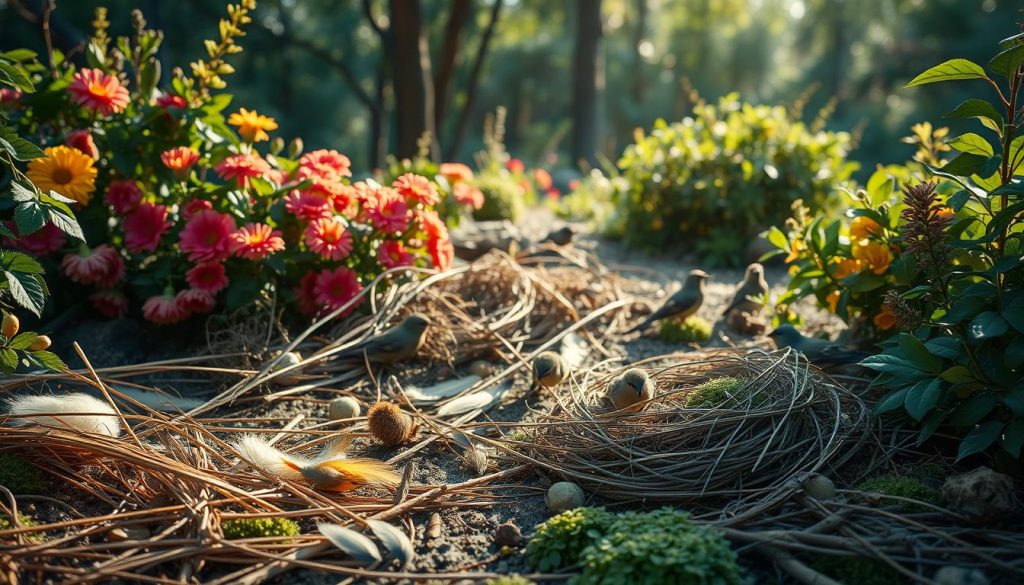
How to Offer Nesting Supplies
I’ve found several effective ways to offer nesting materials. One method is using mesh bags filled with various supplies. I hang these near bird houses and nesting boxes. Another approach is creating bundles of twigs and grass, which I place in sheltered spots around the garden.
To further support nesting birds, I install bird houses and nesting boxes in quiet areas of my yard. This extra effort in providing shelter for birds has attracted a variety of species to my garden.
| Nesting Material | Best Placement | Bird Species Attracted |
|---|---|---|
| Twigs and grass | Low bushes | Robins, Finches |
| Pet fur | Tree branches | Chickadees, Titmice |
| Moss | Near water sources | Hummingbirds, Warblers |
Creating a Year-Round Habitat
I’ve learned that a backyard bird habitat isn’t just for summer. Birds need our help all year long. Let’s explore how to make our gardens a haven for feathered friends in every season.
Seasonal Planting Strategies
To create a bird-friendly landscaping that works year-round, I plan my garden with the seasons in mind. In spring, I plant berry bushes that fruit in summer. For fall, I add plants with seeds that last into winter. This way, birds always have food in my yard.
| Season | Plants | Benefits |
|---|---|---|
| Spring | Serviceberry, Dogwood | Early berries, nesting sites |
| Summer | Sunflowers, Coneflowers | Seeds, nectar for hummingbirds |
| Fall | Asters, Black-Eyed Susans | Late-season seeds, insects |
| Winter | Holly, Winterberry | Winter berries, shelter |
Avoiding Winter Cleanups
I used to clean up my garden in fall. Now I know better. Leaving some areas untidy helps birds. Dead plants offer seeds and shelter. Leaf piles hide insects that birds eat. By skipping the big cleanup, I create a natural backyard bird habitat that lasts all winter.
My bird-friendly landscaping changes with the seasons, but it’s always welcoming. By thinking ahead and letting nature take its course, I’ve created a space where birds thrive all year. It’s amazing to see how a little planning can make such a big difference for our feathered neighbors.
Participating in Bird Conservation
Creating a bird-friendly garden is just the start. I’ve learned that joining bigger conservation efforts can help even more. Let’s see how we can help birds beyond our gardens.
Local Programs and Initiatives
Local groups have programs for bird protection and habitat work. I’ve found great ways to help through:
- Citizen science projects like eBird
- Community garden initiatives
- Bird-watching clubs
- Local Audubon Society chapters
These groups need volunteers for many tasks. By helping, I’ve learned a lot about birds and supported important research.
How to Make a Difference
There are many ways to help birds beyond our gardens. I’ve found these actions very rewarding:
- Participating in annual bird counts
- Advocating for bird-friendly policies in my community
- Supporting conservation organizations
- Educating others about bird-friendly gardens
By doing these things, I’ve made my garden’s impact bigger. I’ve also met others who love birds as much as I do.
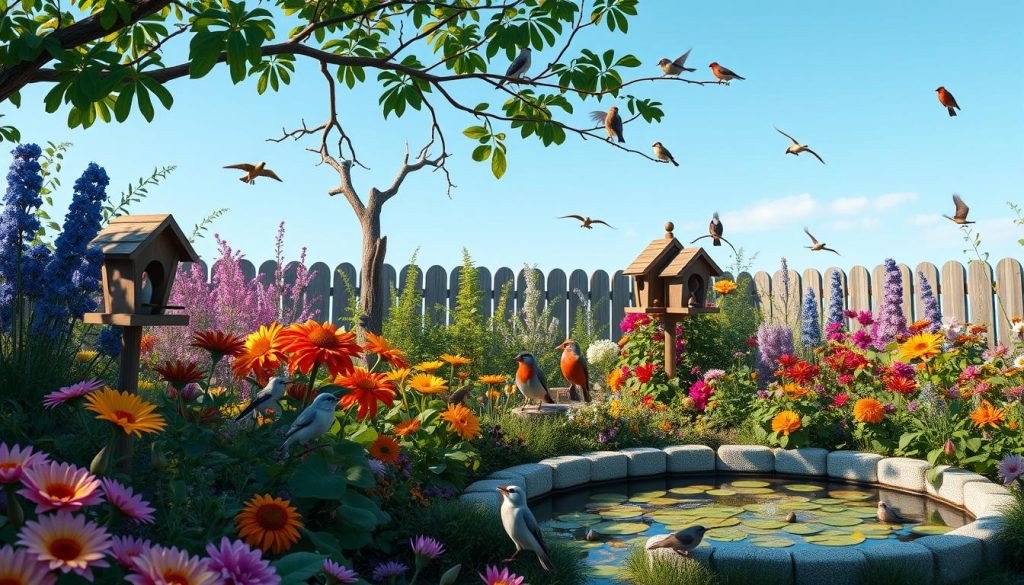
| Conservation Activity | Impact | Time Commitment |
|---|---|---|
| Annual Bird Count | Contributes to population data | 1 day per year |
| Habitat Restoration | Improves local ecosystems | Monthly or as needed |
| Community Education | Spreads awareness | Ongoing |
By joining these efforts, my love for birds has grown. It’s incredible how a simple garden can lead to big changes.
Monitoring Bird Activity in My Garden
Watching the birds in my backyard has become a fun hobby. It’s not just about attracting them; it’s about understanding their habits. By tracking their activity, I make my garden more welcoming for them.
Keeping Track of Species
I keep a simple bird journal. Every day, I write down the birds I see, how many, and any cool behaviors. This shows me patterns and how well my garden attracts birds. I have a list of common birds to help me identify them:
- American Robin
- Northern Cardinal
- Blue Jay
- Black-capped Chickadee
- American Goldfinch
Using Birdwatching Apps
I’ve started using birdwatching apps to help me. These apps make identifying and recording birds easier. Here’s a look at the apps I find most helpful:
| App Name | Key Features | Ease of Use |
|---|---|---|
| Merlin Bird ID | Photo ID, Sound ID, Customized bird list | Very Easy |
| eBird | Global database, Tracking lists, Rare bird alerts | Moderate |
| Audubon Bird Guide | Field guide, Migration maps, Bird songs | Easy |
By watching the birds, I learn how well my garden attracts them. It helps me choose the right plants and where to put feeders. This makes my backyard a great place for birds.
Inspiring Others to Join In
My bird-friendly garden is now a lively spot for local wildlife. I’ve picked up a lot about creating such a garden. It’s incredible how small changes can greatly help our bird friends.
Sharing My Bird-Friendly Garden
I’ve started inviting neighbors and friends to see my garden. It’s a great way to show off bird-friendly landscaping. I show them the native plants, water spots, and feeding areas that draw birds.
People are often amazed at how simple and rewarding it is to create a bird haven.
Organizing Community Workshops
To reach more folks, I’ve started hosting workshops in my garden. These sessions teach the basics of bird-friendly landscaping. We discuss the right plants, setting up feeders, and making safe bird spaces.
It’s thrilling to see people leave with new ideas and a desire to start their own bird-friendly gardens.
By sharing my knowledge, I aim to inspire a network of bird-friendly gardens in our community. Together, we can significantly help local bird populations, one garden at a time.

